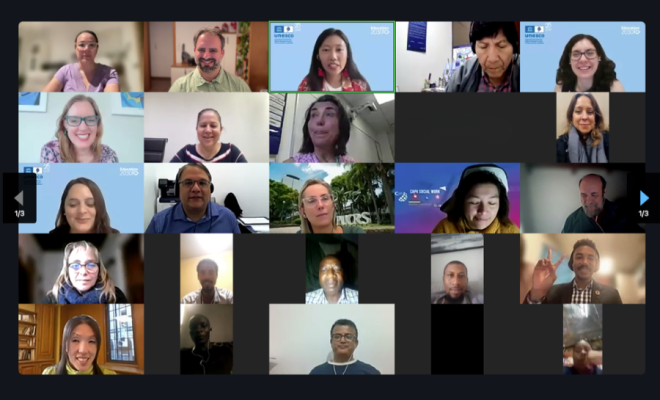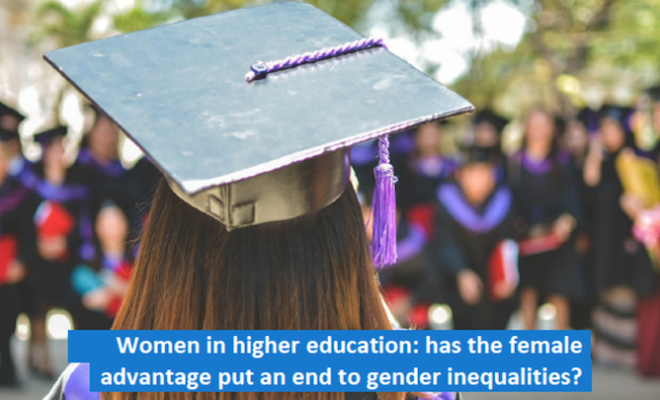Day 5- University networks debated the futures of higher education in the region and the world

On November 3, the closing day of IESALC’s anniversary program, was dedicated to the future of higher education in the region and globally, in a debate in which representatives of higher education networks in Latin America and the Caribbean took the floor, preceded by a video in which the voices of the sector’s leaders opened the conversation.
Participating in the debate were Oscar Domínguez, Executive Director, Association of Colombian Universities (ASCUN) and President of the Board of Directors of the Latin American and Caribbean Higher Education Area (ENLACES); Roberto Escalante, Secretary General, Union of Universities of Latin America and the Caribbean (UDUAL); Héctor Sauret, President, Network of Latin American and Caribbean Private University Associations (REALCUP); Rodrigo Arim, Vice President, Association of Universities of the Montevideo Group (AUGM); Marcelo Di Stefano, Executive Secretary, Confederation of University Workers of the Americas (CONTUA) and Héctor Ulloa, Student, former member of the Steering Committee, Global Student Forum; all under the moderation of Francesc Pedró, UNESCO IESALC Director.
The conversation began with a first generative question: what do you consider to have been the most important achievements of higher education in the last 25 years? For Rodrigo Arim, achievements are inseparable from challenges, but the most eminent for tertiary and higher education systems in the Southern Cone and in Uruguay has to do with the growth of university enrollment and with the possibility that young people from increasingly diverse and vulnerable backgrounds are also gaining access to higher education. Another achievement is the university networking that affects quality processes and that did not exist in the times of the dictatorships in the South. “The disruptive authoritarianism of the 1970s still has consequences in our academic lives and I think we must be aware that we are overcoming it, but that Latin America and the Southern Cone in particular still have a dimension in this area that has to do with these legacies that are not exactly blessed,” he warned.
Marcelo Di Stefano highlighted some milestones of higher education in Argentina, such as the Cordoba Reform in 1918, as a point that models the system and gives it a unique imprint in the world, expanding to the entire region; free education; unrestricted admission; and in the last 25 years, the creation of new universities. “This means taking the university to where our people are, which also made it possible to incorporate into university life the first generations that did not have the possibility of reaching the large urban centers to attend the educational processes. I believe that this is the great achievement of these 25 years of the Argentine university system”.
To this is added the collective bargaining agreement, a collective bargaining system that recognizes the autonomy of 57 national universities that periodically negotiate working conditions and salaries with union organizations. “We usually say that it is impossible to achieve quality goals if we do not have the guarantee of decent work inside the classrooms, inside the universities, inside the workshops, inside the research centers.”
Oscar Domínguez described the experience of Colombia, where higher education institutions increased by a little over 20%, from some 240 to 300 as part of a mixed system. “In this way, these new institutions have a presence in almost 400 of 1 100 municipalities, an advance in access through more higher education institutions, but this access is also reflected in coverage. We had 1,400,000 students in 2000. Today we are close to 2,500,000, which shows an important coverage work that could be 54% today.”
Domínguez highlighted progress in the dropout rate, which continues to be a problem throughout Latin America, having been reduced in Colombia from 12% 25 years ago to 9% at present. As for the participation of women, Colombia has 999,000 men and 1,300,000 women in higher education, 200,000 more students than men; and in terms of quality, the figures speak of 13,000 teachers with master’s and doctoral degrees, with advances in research groups between 80% and 85% in higher education institutions.
For Roberto Escalante, progress is quite unsatisfactory, with very low coverage in Central America, Paraguay and the region in general. In terms of capacity and access, private education has advanced, not public education, and this shows a great lack of interest on the part of the States in supporting public higher education.
“I think we should be concerned about what students and professionals graduating from our universities think about the society in which we live marked by economic inequality. One of our future challenges is to see if, from that science that we are creating with more students, with more universities, especially private universities with respect to public ones, we are really educating young people with a vision of social commitment.”
Representing private higher education, Héctor Sauret brings up the importance of the three UNESCO World Conferences on Higher Education, which in turn corresponded to three other conferences in Latin America and the Caribbean, in the context of which the birth and development of current higher education systems took place, in the light of UNESCO’s orientations that take higher education in its universal dimension. He also highlights the role of IESALC in the strengthening and development of inter-university dialogue in our region, for example through the meetings of networks and councils of rectors. Sauret also recalls, in the framework of this conversation, the mixed character of higher education in the region. “University initiatives of state and private origin coexist and develop in the form of collaboration and complementation.”
Sauret welcomes the creation of new universities with quality validation and as a great challenge observes the social fractures and marginality. “I want to return to a central question of the thinking of the university reform, which emphasizes that the university is not an island, but is inserted in the context of society, of its time. And it is here where the dialogue of the universities must develop, as this panel does, in a greater interrelation with the thinking of university workers. I believe that this panel is very opportune to revalidate the role of IESALC and I would suggest that the best times are those of the future, in the sense that it can stimulate more inter-institutional interstate dialogue”.
Student participation takes center stage in Héctor Ulloa‘s speech, who highlights the protagonist “reconquest” of the student body in the region as a former Honduran student: “In Honduras student participation was completely abolished, and it is in this last decade that it has been recovered and that the National Autonomous University of Honduras is once again a university with student representation and where students are part of the university co-government; I see many challenges in terms of democratic governance in the region”.
On the other hand, he highlighted the democratic nature of university co-government and the importance that, in young universities, professors, as well as other members of the university community, can co-govern and seek to move forward and strengthen the educational system. He highlighted the role of the Global Student Forum that was created in 2019 from the merger of five global organizations and promotes the student perspective for the strengthening of education systems.
“Latin America has been making great progress in terms of having a greater international presence in research issues, there are more students in master’s degrees, doctorates, better research centers that have emerged in the region in recent years. This puts us on the global map, also with our own epistemologies, as is the case of the intercultural and indigenous universities in Nicaragua with URACCAN, in Colombia with the UAEM, universities that have come to break traditional patterns of knowledge, with integration of knowledge and helping to reconcile these different ways of knowing that in the end give us better prospects to take on the challenges we see in the world, such as climate change”.
The main challenges for higher education in the region for the future are also mentioned, among them stratification, the absence of public policy instruments that promote the complementarity of higher education systems and institutions within countries and across countries, the promotion of the creation of common research spaces between universities of university communities, and the need to preserve the democratic character of the University: “The university must also be an environment where values and democratic discussion are promoted. A deliberative democracy where the argument clarifies the differences that exist and where the university has a key role”, stressed Arim.
For Di Stefano, the vision for the future must break with the idea of the university as an island and archipelago to become a university for the construction of a process of equitable social development, involved with the challenges of the future. This involves meeting the challenges of digitization from a democratic perspective, with a process of ongoing training of teachers and non-teaching staff.
Another pending issue is the contribution of HE to the Sustainable Development Goals. “The figures indicate that we are not on track to meet them. And I believe that we must set ourselves a great challenge there,” said Domínguez, who recognizes the existing debt with the rural sector and that progress on the issues of duration and relevance of programs is only possible with a public policy for teacher training, an education that resolves the paradigm of the focus on productivity and that takes into account the development of human beings and their environment. “Peace as a central element for us continues to be our great paradigm. Our dictatorships ended in 1957, but the level of conflict that Colombia suffers today continues to be an important and complex element”.
It is essential to work together to make progress on these issues, but also to implement sustained long-term policies. “The importance of dialogue and articulation between universities and the State must be highlighted. But I believe that this reference would be incomplete if the dialogue did not also include the market,” said Sauret.
Another pending issue is the financing of public universities in the region. “Several countries want to start making changes regarding the issue of tax justice; the university should have a role to share with the population and with our societies and explain to them the need to strengthen our tax systems, since they are one of the best tools we have to combat the inequity that is experienced in the region. I believe that this is something that can help us begin to solve everything else, in addition to strengthening and improving our university systems,” said Ulloa, who works at a fiscal policy research center in Oslo.
In closing, the Institute’s director thanked the audience for their interventions in the chat, as well as the ideas discussed during the two hours of this last anniversary panel, “It has been not only a cross-fire session in more than one sense, but also very lively, very passionate in the best sense of the word, and also with some novel ideas and with interventions in which we have seen ourselves reflected. Thank you very much.”
Other videos:
Higher education leaders share their opinions based on the question: What do you consider to be a great challenge for higher education in the future?
With the participation of José Joaquin Brunner, Director at the Unesco Chair in Comparative Higher Education Policy; Norberto Fernández Lamarra, Director of Postgraduate Studies at Universidad Nacional de Tres de Febrero; María Augusta Hermida, rector at the Universidad de Cuenca; Laura Ramírez Saborío, Executive Director at SINAES; and Oscar Domínguez, Executive Director at ASCUN.
UNESCO IESALC: Meet its people!
What excites you about your work at UNESCO IESALC? Our team celebrates this quarter of a century by reaffirming its commitment to the Institute and to the work for promoting the achievement of quality higher education for all.
Historical evolution of the Journal Higher Education and Society ESS
Débora Ramos, Academic Specialist at UNESCO IESALC, presents the historical development of the journal Educación Superior y Sociedad (ESS), a periodical journal published by the UNESCO International Institute for Higher Education in Latin America and the Caribbean (IESALC), which is the main space for dissemination and approach to scientific research in Universities and Higher Education Institutions in Latin America and the Caribbean and other regions. With more than 30 years of active presence in the region, ESS is mainly oriented to the dissemination of research works and theoretical studies on the field of higher education and its thematic trends.
RELATED ITEMS








